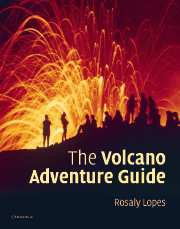Book contents
- Frontmatter
- Contents
- Preface
- Acknowledgments
- PART I Choosing a volcano to visit
- PART II Guides to volcanoes
- 6 Introduction to the field guides
- 7 Volcanoes in Hawaii
- 8 Volcanoes in the continental USA
- 9 Volcanoes in Italy
- 10 Volcanoes in Greece
- 11 Volcanoes in Iceland
- 12 Volcanoes in Costa Rica
- 13 Volcanoes in the West Indies
- Appendix I Useful information for preparing a volcano trip
- Appendix II Tours to volcanoes
- Bibliography
- Glossary
- Index
7 - Volcanoes in Hawaii
from PART II - Guides to volcanoes
Published online by Cambridge University Press: 01 September 2010
- Frontmatter
- Contents
- Preface
- Acknowledgments
- PART I Choosing a volcano to visit
- PART II Guides to volcanoes
- 6 Introduction to the field guides
- 7 Volcanoes in Hawaii
- 8 Volcanoes in the continental USA
- 9 Volcanoes in Italy
- 10 Volcanoes in Greece
- 11 Volcanoes in Iceland
- 12 Volcanoes in Costa Rica
- 13 Volcanoes in the West Indies
- Appendix I Useful information for preparing a volcano trip
- Appendix II Tours to volcanoes
- Bibliography
- Glossary
- Index
Summary
All the Hawaiian islands were created by volcanoes. Repeated eruptions for many millennia slowly built up the volcanoes from the bottom of the ocean, until lava broke thorough the surface and island after island was created. At first, there was only black, basaltic lava on the islands. Everything else – the plants, the animals, the people – came to Hawaii from distant lands across the Pacific. The volcanoes are the only original Hawaiians, there long before the coral reefs grew and the first palm tree swayed in the breeze.
Kilauea, Mauna Loa, and East Maui (Haleakala) are three of the youngest and most active Hawaiian volcanoes. Haleakala has erupted only once in recorded history, sometime around 1790, but is still potentially active. Mauna Loa, the largest single mountain on Earth, erupts every 10 years or so, and Kilauea – one of the world's most active volcanoes – has been erupting continuously since 1983.
Hawaii has named the most civilized type of volcanic eruption: it is both spectacular and relatively safe to watch. Few people have died because of Hawaii's volcanic activity, though the lava flows can greedily eat up land and houses, sometimes whole towns. But there is a fruitful side to these frequent eruptions: the long lava flows often reach the ocean, creating new land and yet another black sand beach.
Compared to European volcanoes, Hawaii is a new contributor to the scientific understanding of how the Earth works,
- Type
- Chapter
- Information
- The Volcano Adventure Guide , pp. 67 - 106Publisher: Cambridge University PressPrint publication year: 2005

